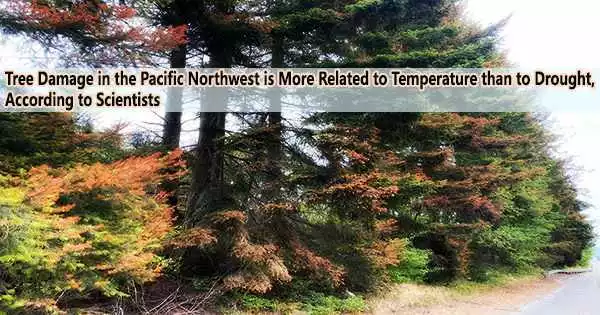According to researchers from Oregon State University, widespread tree scorch that appeared in the Pacific Northwest quickly after several days of record-breaking, triple-digit temperatures in June 2021 was more due to heat than to drought conditions.
A team led by Christopher Still of the OSU College of Forestry presents evidence in a paper that was published in Tree Physiology that leaf damage and discoloration are consistent with being exposed to solar radiation directly during the hottest afternoons of the “heat dome” that encircled northwest North America.
Still and other OSU researchers were responding to a paper from April 2022 that concluded that drought and a malfunction in the hydraulic system of trees, which aids in transpiration, the process by which water vapor is exhaled by foliage to keep it cool, were to blame for the problems with the trees.
The collaboration that produced the response following a literature review includes researchers from Oregon State’s colleges of Engineering, Agricultural Sciences, and Earth, Ocean, and Atmospheric Sciences, as well as two other OSU-affiliated organizations, the Oregon Climate Change Research Institute, and the PRISM Climate Group.
“While we think the drought/hydraulic hypothesis is partly true, we argue that multiple lines of evidence suggest the main issue was in fact direct heat damage,” said Still, a tree physiologist who studies forests in the context of climate change impacts and feedbacks. “Tree physiologists have worked a lot to show that hydraulic damage in response to drought drives a lot of tree mortality, and the paper we comment on more or less fits in that vein, implying that what we saw in June 2021 was just another example of drought damage and that the heat dome was a sort of extreme drought event.”
Disentangling drought from heat damage is tricky, and we argue the research community needs to work much more on heat stress physiology. We need to explore connections between hydraulic properties and heat tolerance safety margins, how evolution may have helped some species with heat tolerance, canopies’ ability to maintain leaf temperatures below damaging thresholds. What happened during the heat dome argues for a renewed emphasis on understanding the underlying physiological and biophysical mechanisms that can lead to heat resilience.
Christopher Still
Still and OSU colleagues including ecologist and plant pathologist Posy Busby, H.J. Andrews Experimental Forest Director Mark Schulze, forest health specialist David Shaw, hydrologist David Rupp and geospatial climatologist Chris Daly say that damage can be driven by extreme heat alone, irrespective of prior hydrologic context and water availability.
The heat dome, according to them, was the most intense heat wave to ever be recorded anywhere in the world and in the Northwest. The scientists also point out that there is “a clear distinction in the climate and hydrometeorological literature between droughts and heat waves” and that “heat waves are not just associated with droughts, as is commonly assumed, but are increasing in frequency during both wet and dry conditions.”
“Among coastal Douglas-fir and western hemlock plantation forests in western Oregon and Washington, the most extensive impacts of the heat dome were in areas experiencing comparatively low levels of drought,” the authors say.
Conversely, many forests around Oregon’s Willamette Valley and along the western slopes of the Cascade Range that were experiencing severe to exceptional drought during the heat dome showed less foliar damage.
“It’s also important to remember that conifer needles can discolor for many reasons besides being dried out,” Still said.
According to Still, much of the observed “foliar scorch” had characteristics similar to those of heat from fires and displayed patterns that indicated heat was the predominant cause of foliar damage during the heat dome.
In general, trees on the south and west-facing slopes and on exposed edges close to roadsides exhibited the most scorch, while trees on their opposite sides or other trees on the same hillsides exhibited little to no scorch.
“The scorching that did occur happened fast, within days and sometimes hours, much faster than would typically be associated with a malfunction of the trees’ water moving capabilities,” Still said. “And the prevalence of scorching in sunlit foliage also challenges the hypothesis that drought and hydraulic failure combined to be the primary cause of leaf damage.”
“Our prior work has shown drought-induced foliar browning in conifers can take weeks or even months to appear after lethal levels of drought stress,” added co-author William Hammond, an assistant professor of plant ecophysiology at the University of Florida.
The researchers stress that they are not denying that hydraulics may have contributed to the leaf damage or the later death of certain trees, but that the scorch patterns seen in the Pacific Northwest during and after the heat dome are best explained by severe heat.
“Disentangling drought from heat damage is tricky, and we argue the research community needs to work much more on heat stress physiology,” Still said. “We need to explore connections between hydraulic properties and heat tolerance safety margins, how evolution may have helped some species with heat tolerance, canopies’ ability to maintain leaf temperatures below damaging thresholds. What happened during the heat dome argues for a renewed emphasis on understanding the underlying physiological and biophysical mechanisms that can lead to heat resilience.”
College of Forestry research associate Adam Sibley is a co-author of the commentary, as are scientists from the U.S. Forest Service and a pair of Australian organizations, Biodiversity and Conservation Science and the Commonwealth Scientific and Industrial Research Organization.





